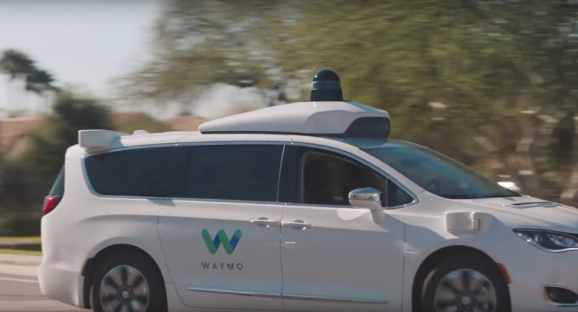Above: A self-driving vehicle developed by Google parent company Alphabet’s Waymo.
KYLE WIGGERS@KYLE_L_WIGGERS
Source: venturebeat.com, October 2019
Waymo’s self-driving Chrysler Pacificas have arrived in yet another test city: sunny Los Angeles, California. The Alphabet subsidiary today revealed that it’s begun mapping roads in the City of Angels, a step toward the building of the databases necessary for its cars to drive autonomously. It’s the latest expansion of pilots in the cities of Novi, Kirkland, Washington, San Francisco, Phoenix, and Miami, the last of which kicked off as recently as August.
Waymo vans outfitted with lidar sensors, radar, cameras, and powerful onboard computers have begun roving the streets of L.A., concentrated around the populous downtown Miracle Mile section of Wilshire Boulevard. They’re currently being driven by technicians, and Waymo says it has no immediate plans to expand its driverless taxi service to the region. Instead, product manager for mapping David Margines told Forbes that the plan is to study L.A. congestion.
“Congestion is a totally different thing, and we’re really excited to see how that congestion kind of manifests itself,” said Margines, who revealed that Waymo’s working with the L.A. Department of Transportation. “Is it similar to San Francisco congestion and the behavior of San Francisco? [We suspect not,] given the way L.A. is kind of built around the vehicle, [where] the layout of it [might allow] drivers to make fewer lane changes … or double-park fewer times.”
It’s been over six months since Waymo launched Waymo One, its commercial driverless taxi fleet of over 600 cars with safety drivers behind the wheel, and the company says the fleet has grown to serve over 1,000 riders in that time. Separately, Waymo recently revealed that its cars have driven 10 billion autonomous miles in simulation and 10 million real-world autonomous miles in 25 cities.
Weeks after Waymo announced it would dedicate a factory in southeast Michigan to the production of level 4 autonomous cars — that is, cars capable of driving without human supervision in most conditions — the company said it had settled on a location in Detroit. Separately, Waymo partnered with Lyft to deploy 10 of its vehicles on the ride-hailing platform in Phoenix.
Waymo currently operates a roughly 20-person, 53,000-square-foot office in Novi, Michigan that opened in 2016. The company tests driverless Chrysler Pacifica hybrid minivans in Detroit that are produced in Windsor, Canada and shipped to Novi, where they’re outfitted with hardware and software by Waymo and Chrysler engineers. In Chandler, Arizona, Waymo last year expanded its full service center — which houses operations and support teams, including fleet technicians, dispatch, response, and rider support — to 60,000 square feet. More recently, the company pledged to open an 85,000-square-foot technical service center in the city of Mesa, Arizona, near Phoenix’s East Valley, and it expects to “more than double” its capacity to maintain the fleet of cars in Waymo One.
Waymo also announced last year that it would add up to 62,000 minivans to its fleet and said it had signed a deal with Jaguar Land Rover to equip 20,000 of the automaker’s Jaguar I-Pace electric SUVs with its autonomous system by 2020.
Waymo has competition in Yandex, Tesla, Zoox, Aptiv, May Mobility, Pronto.ai, Aurora, Nuro, and GM’s Cruise Automation, to name just a few. Daimler last summer obtained a permit from the Chinese government that allows it to test autonomous cars powered by Baidu’s Apollo platform on public roads in China. Beijing-based Pony.ai, which has raised $214 million in venture capital, in early April launched a driverless taxi pilot in Guangzhou. And startup Optimus Ride this month built out a small autonomous shuttle fleet in New York City, becoming the first to do so.
According to marketing firm ABI, as many as 8 million driverless cars will be added to the road in 2025, and Research and Markets anticipates that there will be some 20 million autonomous cars in operation in the U.S. by 2030.

